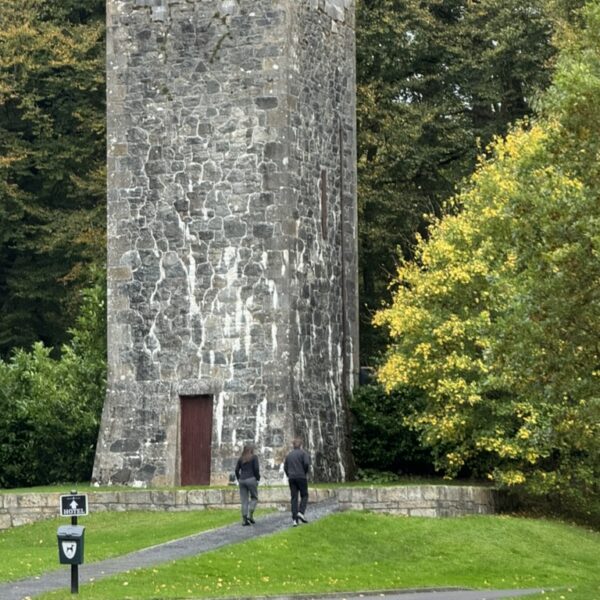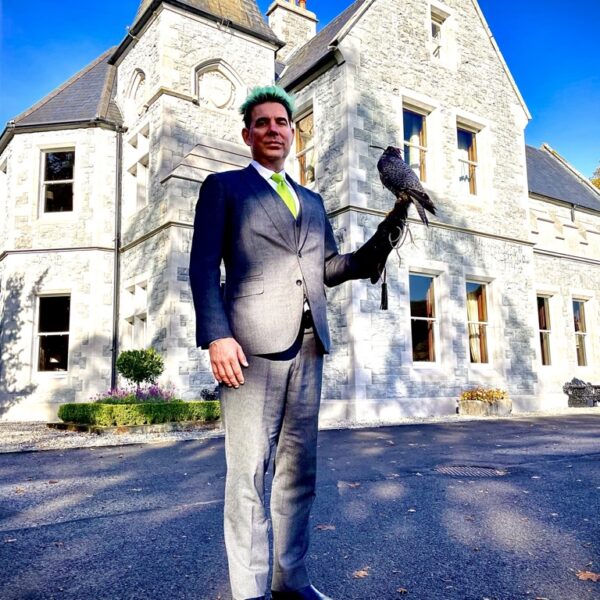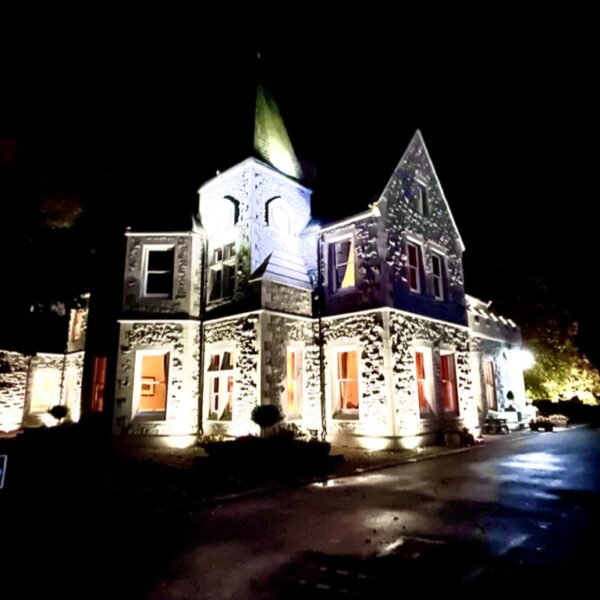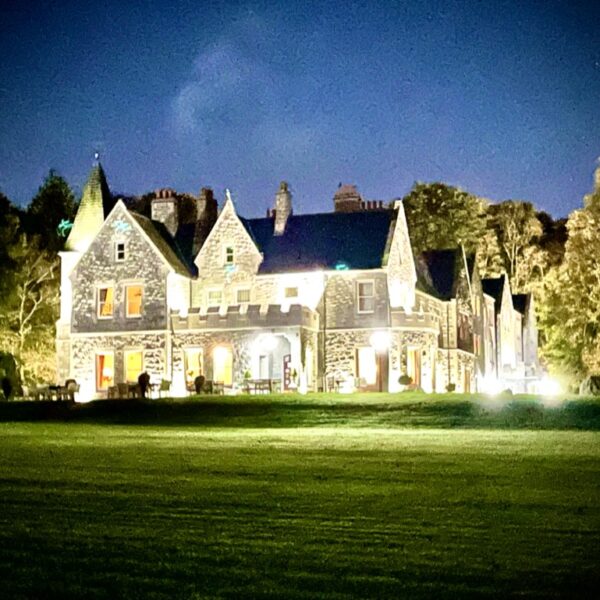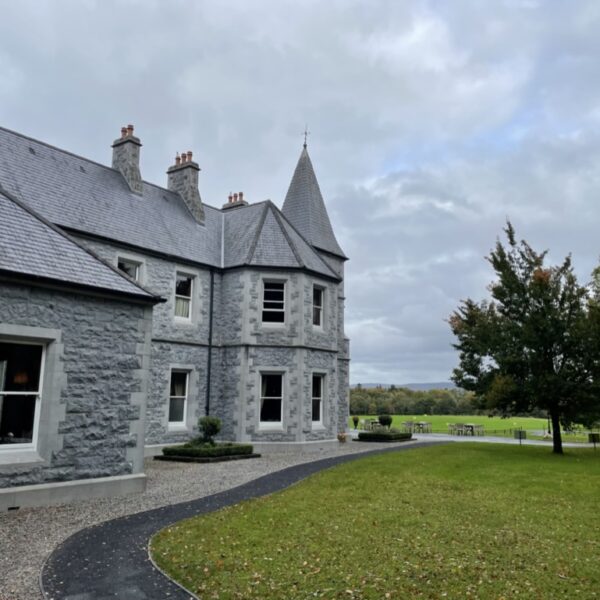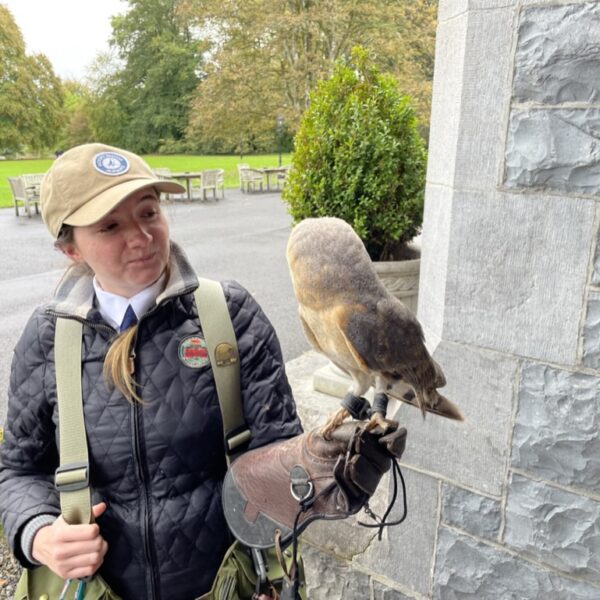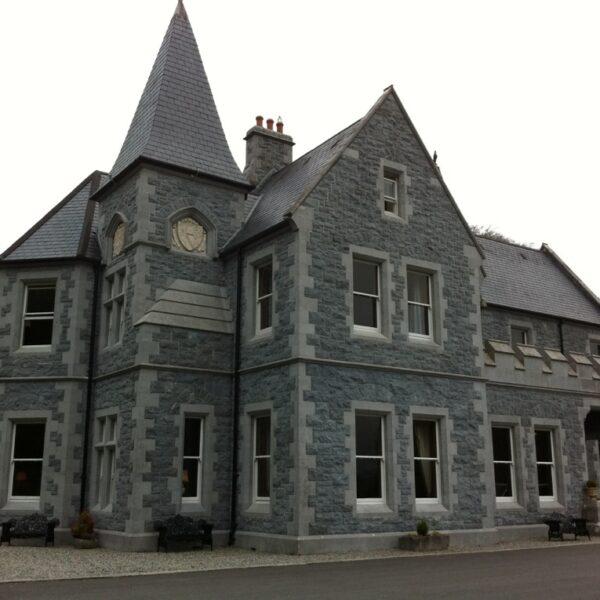Mount Falcon
January 21, 2025 2025-07-10 3:26Mount Falcon
Mount Falcon Estate
A Jewel in Mayo’s Crown and its Place in the O’Dubhda Narrative
Where History and Heritage Converge in the Heart of O’Dubhda Lands
Nestled amidst the serene landscapes of County Mayo, Mount Falcon Estate stands as a testament to centuries of Irish history and natural beauty. While the estate itself boasts a rich lineage of ownership by families such as the Knoxes and Aldridges, and now the Maloney family, its very location lies within the ancient and enduring territories of the Ó Dubhda clan, also known by their anglicized forms O’Dowd, O’Dowda, and Dowd. This report explores the captivating story of Mount Falcon, from its earliest land roots to its present-day grandeur, and places it within the profound historical narrative of the O’Dubhda clan, whose presence has shaped the very fabric of Northwest Connacht for over a millennium.
I. Overview: Journey Through Time at Mount Falcon Estate
This section sets the stage for Mount Falcon, introducing its geographical context and its long history, emphasizing its position within the broader O’Dubhda ancestral lands.
Mount Falcon Estate is a majestic and historic destination located in the stunning County Mayo countryside, specifically on the west bank of the River Moy, nestled between Foxford and Ballina. Its prime position in the heart of the Wild Atlantic Way underscores its natural beauty and strategic location, making it a significant landmark in the region. The land itself has been sought after for at least 400 years, with archaeological evidence suggesting continuous human habitation and purpose in these vistas and flood plains possibly as far back as 5,000 years ago. This deep historical layering of the land predates even the establishment of the estate itself, connecting it to a much more ancient past. The long history of human interaction with this landscape, spanning millennia, suggests a deep and continuous significance of the area around Mount Falcon, extending beyond the more recent construction of the estate itself. This deep temporal perspective places Mount Falcon within a broader historical narrative of the O’Dubhda clan’s ancestral lands, aligning with the clan’s own extensive lineage in the region.
The estate, spanning 100 acres of lush woodlands, has undergone remarkable transformations throughout its documented history. From its origins as Hollywood House, a dwelling built in 1826, to the grand Victorian Gothic manor constructed in 1876, and its subsequent evolution into a renowned luxury hotel, Mount Falcon has continuously adapted while meticulously preserving its historic character. Today, it is celebrated for seamlessly blending Ireland’s rich heritage with modern luxury, earning its place as one of the region’s most beloved and historically significant estates.
II. The Storied Past: Mount Falcon Through the Ages
This section chronicles Mount Falcon’s historical journey, from its land acquisition to its modern status, highlighting key ownerships and developments.
A. From Ancient Roots to Knox Legacy
The formal history of the Mount Falcon demesne as currently recognized began in the 1820s. During this period, Major John Knox, a prominent figure, acquired over 2,000 acres of land from Captain Edward Watts, a soldier who had received the land as a grant after serving under Cromwell in the mid-17th century. This acquisition laid the foundation for the estate’s development. It was Major Knox’s eldest son, John Frederic Knox, following his marriage to Anna Maria Knox-Gore of the distinguished Belleek Manor family, who oversaw the construction of the first significant dwelling on the property in 1826. This initial residence, later known as Hollywood House, served as the de facto seat of the Knox family. By the late 1830s, the burgeoning Mount Falcon was already recognized as a handsome estate, even boasting a popular horse track that drew locals.
During the devastating Great Irish Famine of the mid-1800s, John Knox demonstrated remarkable benevolence by establishing a soup kitchen at Hollywood House to provide sustenance for his starving tenants. This act of compassion and generosity likely fostered goodwill within the local community. This compassionate approach, along with Captain Knox’s later policy of not collecting rent from staff, appears to have been a critical factor in the survival of Hollywood House and the later manor house during the turbulent War of Independence and Civil War. During these periods, many other grand houses were destroyed, suggesting that positive landlord-tenant relations, characterized by support and fairness, could significantly influence the fate of Anglo-Irish estates amidst intense social and political upheaval. Such actions highlight a social dynamic where humanitarian efforts could contribute to the preservation of property.
B. The Victorian Era and the Grand Manor
Upon John Knox’s passing in 1871, the estate, including Hollywood House and a sum of £3,000, was bequeathed to his second son, Utred Augustus Knox. This inheritance specifically stipulated that the £3,000 was designated for the construction of “a mansion house at Mt. Falcon”. Utred commissioned the renowned architect James Franklin Fuller for the ambitious project. Fuller, a prominent figure known for his work on other iconic Irish structures like Kylemore Abbey, Ashford Castle, and Farmleigh House, initially deemed Utred’s proposed budget of £2,000 “Impossible” for a house of the desired quality. After extensive negotiations, the cost escalated significantly, with the contracted builder Henry Sharpe quoting £5,800, eventually settling on £6,650 in October 1872. The signed contract, a tangible piece of the estate’s history, is still proudly displayed in the Boathole Bar.
By the time the grand home was finished and furnished in 1876, Utred Knox had leveraged himself to the tune of £10,000, an amount equivalent to nearly €2,000,000 in today’s Euros. A substantial contribution came from Lady Sarah Knox-Gore, Utred’s future mother-in-law, who provided a significant loan of €5,450, insisting on a residence suitable for her daughter Agnes’s social status. The significant financial investment and the involvement of a prominent architect like James Franklin Fuller underscore the ambition and social standing of the Knox family in the late 19th century. This was not merely a house but a deliberate statement of wealth, prestige, and social standing, reflecting a broader trend of grand estate building among the Anglo-Irish gentry during the Victorian era, often driven by marriage alliances and a desire to consolidate influence.
C. Transition and Transformation: From Private Residence to Esteemed Hotel
The 20th century ushered in significant changes for Mount Falcon and indeed all of Ireland. In December 1916, Captain Utred Arthur Frederic Knox, the only male heir, began downsizing his extensive holdings after returning from the Great War, a common trend among wealthy landowners of the era who could no longer afford to maintain vast estates. He sold all but 320 acres of the demesne, though he continued to allow his staff to live on the remaining land rent-free, following his father’s benevolent example. Amidst the upheaval of the War of Independence, Captain Knox attempted to generate income by opening a sawmill on the estate in December 1921. However, it was tragically burned to the ground just two months later, allegedly by an angry ex-employee, and was never reopened.
In 1932, Captain Knox sold the remaining acreage and the manor house to Major Robert Beauclerk Aldridge for £7,000. Major Aldridge and his wife Constance, affectionately known as ‘Connie,’ were drawn to Mount Falcon for its proximity to the salmon-rich River Moy and its potential for outdoor pursuits. Connie Aldridge became the matriarch of post-WWII Mount Falcon, transforming it into a guesthouse in the mid-1950s and hosting visitors until 2000, when she sold the estate at the age of 91. She was a visionary in the hospitality sector, becoming one of the 11 founding members of Ireland’s Blue Book Association in 1974, an initiative specifically designed to market historic properties and promote their unique charm.
In 2002, the Maloney family – Alan, Barry, and Michael – purchased the property, inspired by Connie’s pioneering work and the Knox family’s enduring heritage. They undertook a massive renovation and restoration program, transforming it into the luxury hotel known today. Mount Falcon has since garnered numerous accolades, including AA Hotel of the Year, IGTOA Boutique Hotel of the Year, and Ireland’s Favourite Place to Stay Connaught. The Maloney family continues to invest significantly in its ongoing restoration, ensuring its historical integrity and charm endure for future generations. The successive transitions of Mount Falcon from a private family estate to a guesthouse and then a luxury hotel exemplify a broader trend in Ireland where large historical properties, no longer economically viable as private residences, found new life through adaptive reuse and commercialization into hospitality ventures. This trend, particularly championed by figures like Connie Aldridge and her involvement with Ireland’s Blue Book, has been crucial for the preservation and sustainable future of many such grand houses across the country.
Table 1: Key Milestones in Mount Falcon’s History
|
Year/Period |
Event/Owner |
Significance |
|
1820s |
Land purchased by Major John Knox |
Establishment of demesne |
|
1826 |
Hollywood House built by John Frederic Knox |
First significant dwelling on the property |
|
Mid-1800s |
Famine soup kitchen established by John Knox |
Act of benevolent landlordism during hardship |
|
1871 |
Utred Augustus Knox inherits estate |
Inheritance includes funds for new mansion |
|
1872 |
Manor house contract signed with Henry Sharpe |
Commencement of grand construction project |
|
1876 |
Manor house completed |
Completion of the main house, a Victorian Gothic masterpiece |
|
1916 |
Captain Knox downsizes holdings |
Post-WWI adaptation, divestment of large estates |
|
1921-1922 |
Sawmill burned down |
Economic hardship and alleged arson |
|
1932 |
Sold to Major Robert Beauclerk Aldridge |
Change of ownership, focus on outdoor pursuits |
|
1932-1999 |
Aldridge family ownership / Guesthouse operation |
Transition to hospitality, founding of Ireland’s Blue Book |
|
2002 |
Maloney family purchase and renovation |
Modernization and transformation into luxury hotel |
|
Present |
Luxury hotel operation |
Continued awards and commitment to restoration |
III. Architectural Marvels: Unveiling Mount Falcon’s Design
This section delves into the distinctive architectural features of Mount Falcon, emphasizing its design and the vision behind its construction.
A. Victorian Gothic Splendor
Mount Falcon Estate is renowned for its striking Victorian Gothic design, a style popular in the 19th century that evokes a sense of grandeur, historical romance, and often a picturesque quality. The manor house, meticulously constructed with grey cut limestone, presents an imposing and elegant sight, characteristic of the finest Anglo-Irish Country Houses of its era. Key architectural features that define its splendor include ornate stone facades, which showcase the intricate craftsmanship and attention to detail prevalent in 19th-century construction. Within, the grand interiors exude a timeless atmosphere, characterized by exquisite period features such as rich wood paneling, soaring high ceilings, and magnificent elegant fireplaces, all contributing to the estate’s luxurious and historically resonant ambiance.
B. Fuller’s Enduring Vision
The architectural brilliance of Mount Falcon is largely attributed to James Franklin Fuller, the distinguished architect commissioned by Utred Augustus Knox for this ambitious project. Fuller’s design for Mount Falcon, completed in 1876, stands as a testament to his distinctive style and his commitment to creating grand, yet functional, spaces. His enduring legacy is particularly evident in the dramatic central staircase and the imposing foyer entrance, which continue to be prominent highlights of the hotel today, captivating visitors upon arrival. Fuller’s architectural prowess extended to other notable Irish landmarks, including the iconic Kylemore Abbey, the majestic Ashford Castle, and the stately Farmleigh House, thereby placing Mount Falcon within a distinguished and celebrated architectural lineage.
While the house has undergone thoughtful conversions to adapt to its modern role as a luxury hotel—such as the transformation of the original kitchen into a sophisticated dining room and a former sitting room into the charming Boathole Bar with picturesque views of the Ox Mountains—the fundamental charm, character, and provenance of Fuller’s original design have been meticulously maintained. The continuity of Fuller’s original architectural design despite significant functional changes demonstrates a conscious and commendable effort to preserve the historical integrity of the estate. This reflects a broader appreciation for heritage architecture in Ireland, where adaptive reuse prioritizes maintaining the original aesthetic and structural elements, ensuring that the past informs the present. This careful preservation ensures that the historical integrity of the building remains intact.
IV. Legends and Lore: Tales from Mount Falcon’s Shadows
This section explores the captivating stories and anecdotes that have become intertwined with Mount Falcon Estate, adding layers of intrigue and character to its history.
A. The Romantic Origins
At the heart of Mount Falcon’s captivating lore is its profoundly romantic genesis: it was originally constructed in 1876 as a magnificent wedding gift from Utred Augustus Knox to his beloved bride, Constance Gardiner. Legend holds that Constance harbored a vivid dream of living in a “castle-like home,” a personal vision that is said to have profoundly influenced the estate’s distinctive Victorian Gothic design. This enchanting origin story has earned Mount Falcon the enduring and endearing reputation as “the most romantic house in Ireland”.
B. Echoes of Resilience and Human Drama
The land itself holds ancient echoes, with the original dwelling on the estate known as Hollywood House, a name that “foreshadowed an impossibly imagined future 200-years later”, hinting at a destiny beyond its initial purpose. A unique circular enclosure on the estate, strikingly resembling an ancient earthen rath or fort, serves as the dignified burial plot for several members of the Knox family. This sacred site, which overlooks the symmetrical Nephin Mountain and is located in close proximity to an ancient wedge tomb known as ‘Darby’s Bed’, intricately intertwines the family’s legacy with the deeper, ancient, and often mysterious history of the land itself.
The estate also bears witness to moments of human drama and resilience. In the 1920s, Captain Knox’s sawmill, a vital source of income, was tragically burned to the ground just two months after its opening, allegedly by an angry ex-employee who also threatened to set the manor house ablaze. Later, Hollywood House itself sustained smoke damage from an alleged arson attempt by a 70-year-old employee, a “strange case of history repeating itself”. These unfortunate incidents, while challenging, speak to the personal stories and conflicts that unfolded within the estate’s bounds, adding a layer of human vulnerability to its grand narrative.
C. A Legacy of Distinguished Guests
Mount Falcon has long been a magnet for notable figures, drawing in a prestigious array of guests. During her extensive tenure, Connie Aldridge, the estate’s matriarch for decades, famously hosted a remarkable collection of celebrities and dignitaries. These included Hollywood icons such as Vivien Leigh and Peter Sellers, alongside influential former Irish political leaders like Dr. Patrick Hillary and Taoiseach Jack Lynch. This esteemed tradition of welcoming distinguished guests continues seamlessly under the Maloney family’s current ownership. Mount Falcon now regularly hosts “today’s Hollywood royalty, sporting legends, political figures, and even U.S. President Joe Biden prior to his presidency,” a testament to its enduring allure and its status as a premier destination for those seeking both luxury and discretion. The persistent attraction of Mount Falcon for high-profile guests, from the Aldridge era to the present Maloney ownership, reveals a consistent pattern of the estate serving as a discreet and luxurious retreat. This continuity establishes a “legacy of hospitality” that transcends specific owners and highlights the estate’s enduring prestige, appeal, and ability to adapt to changing social landscapes while maintaining its exclusive character.
V. The O’Dubhda Clan and the Landscape of Our Ancestors
This crucial section establishes the deep historical connection of the O’Dubhda clan to the broader region where Mount Falcon stands, clarifying the nature of this connection.
A. The Enduring Legacy of the O’Dubhda (O’Dowd, Dowd) Clan
The O’Dubhda clan, known by its various anglicized spellings such as O’Dowd, Dowd, O’Dowda, Dowds, Doody, and Duddy, boasts one of Europe’s oldest continuously used surnames. The original Gaelic name, Ó Dubhda (pronounced O Dooda), meaning “the Dark One,” derives from the 10th-century King of Connacht, Dubhda. The first to adopt this distinctive surname was Aedh Ua Dubhda (Hugh O’Dowd), who died in 982 AD, marking its place as one of the earliest surnames in Europe.
The clan’s illustrious lineage can be traced back over 1500 years, predating the arrival of St. Patrick in Ireland, and is remarkably older than that of the English Royal Family. They descend directly from Fiachrae, an older half-brother of the famed Niall of the Nine Hostages, through Nath Í mac Fiachrach, also known as Dathí, who was notably the last pagan High King of Ireland. Historically, the O’Dubhda were the leading sept of the northern Uí Fiachrach, a powerful tribal group that dominated the modern counties of Mayo and Sligo. Their ancestral heartland is specifically traced to the Doonfeeney area in Ballycastle, Co. Mayo, where the ancient earthen ring fortification known as ‘Rath O’Dubhda’ still stands as a tangible link to their past.
The clan demonstrated a profound commitment to preserving their heritage, maintaining hereditary historians, most notably the MacFirbis clan. These scholars produced vital works of Irish history, such as the monumental Great Book of Lecan and the Leabhar na nGenealach. These texts meticulously recorded the clan’s genealogies and even a highly detailed account of their chieftain’s inauguration ceremony, offering invaluable insights into ancient Brehon Laws and Gaelic traditions. The O’Dubhda clan’s patronage of scholars like the MacFirbises goes beyond mere cultural support; it was a strategic act to legitimize and preserve their royal lineage and territorial claims against internal and external pressures. This highlights the sophisticated intellectual and political infrastructure of Gaelic society, where meticulous historical record-keeping and genealogical preservation were integral to maintaining power, identity, and the narrative of their fortified kingdom.
B. Fortifications and Strongholds: The O’Dubhda’s Defensive Network
For centuries, the O’Dubhda clan was a formidable military and maritime power, famously maintaining a robust network of “20 castles” that strategically ringed their territory across modern-day Mayo and Sligo. This extensive defensive system was instrumental in their ability to “hold their territory intact against the superior forces of the Burkes and Birminghams” for centuries, demonstrating remarkable resilience. The O’Dubhda’s ability to maintain a kingdom and resist external forces for centuries was directly facilitated by their strategically vital network of castles. This illustrates the critical role of fortifications in preserving Gaelic autonomy, territorial integrity, and cultural identity in the face of Anglo-Norman incursions and later conflicts, highlighting a fundamental aspect of their historical power.
Their diverse fortifications included traditional Gaelic strongholds like older ringfort sites, strategically adapted Norman castles they had captured or contested, and purpose-built tower houses, often referred to as “10-Pound Castles”. Significantly, many of these O’Dubhda castles were built directly over the sites of much older Stone Age and Bronze Age fortifications, indicating a long-standing recognition of key defensive locations and a continuous occupation of strategic points in the landscape. Explicitly identified O’Dubhda strongholds include Rosslee, Rathlee, Enniscrone (which is currently undergoing restoration), Ardnarea, Castleconor (built in 1520 by Conor O’Dowd, the Taoiseach of the time), Carn Amhalghaigh (built in 1477), Carrowmably, and the ancestral ringfort of Rath O’Dubhda, along with Lecan and Grangemore. These sites, whether standing ruins or mere remnants, are not simply historical curiosities but tangible links to a powerful Gaelic lineage that profoundly shaped the history and landscape of Northwest Connacht.
C. Mount Falcon’s Place in the Broader O’Dubhda Territory
It is important for historical accuracy to clarify that while Mount Falcon Estate is a significant and beautiful historical landmark within County Mayo, a heartland of the O’Dubhda clan, the provided historical records do not indicate direct ownership or construction of Mount Falcon by the O’Dubhda clan. The estate’s documented history begins with the acquisition of the land by Major John Knox in the 1820s and the construction of its primary structures by the Knox family in the 19th century. The connection to the O’Dubhda clan is one of geographical context within their ancestral territory rather than direct lineage or historical ownership of this specific estate. This nuance is vital for maintaining factual accuracy and credibility on a website dedicated to historical reference for the O’Dubhda clan.
However, Mount Falcon’s geographical location, nestled between Foxford and Ballina on the banks of the River Moy, places it firmly within the historical sphere of influence and traditional territory of the O’Dubhda (O’Dowd, Dowd) clan, whose domain spanned across modern-day Mayo and Sligo. The clan’s ancestral seat at Rath O’Dubhda in Doonfeeney, Ballycastle, Co. Mayo, and their numerous other strongholds throughout the region, underscore their deep and ancient connection to this very landscape, long before the current estate was conceived. Therefore, while Mount Falcon itself is a later development in terms of specific ownership, it stands as a prominent feature within the ancestral lands that the O’Dubhda clan fiercely defended, governed, and profoundly shaped for over a thousand years. Its presence today contributes to the rich tapestry of history and heritage that defines the O’Dubhda homeland, serving as a modern landmark in a landscape steeped in clan history.
VI. Visiting Mount Falcon Today: A Glimpse into the Past and Present
This section provides practical information for visitors, inviting them to experience the estate’s unique blend of history, luxury, and natural beauty.
A. Location & Access
Mount Falcon Estate is conveniently situated on the west bank of the River Moy, nestled between the towns of Foxford and Ballina in County Mayo, Ireland. Its full postal address is Drumrevagh, Co. Mayo, F26 H744. The estate is ideally located in the heart of the Wild Atlantic Way, making it a perfect and accessible base for exploring Ireland’s spectacular and rugged western coastline. Nearby attractions include the Dolmen of the Four Maols and St. Muredach’s Cathedral. The estate offers ample amenities to ensure a comfortable visit, including generous free parking and complimentary WiFi throughout the property. It is a non-smoking establishment and provides facilities designed to accommodate guests with disabilities. As a luxury hotel and leisure destination, Mount Falcon Estate is generally accessible year-round, offering a continuous opportunity for visitors to experience its charm. Standard check-in is typically from 3:00 PM, with check-out until 11:00 AM. As a commercial hotel and activity center, specific admission costs apply for overnight stays, dining, and various activities. Visitors are encouraged to check the official Mount Falcon website for current pricing and booking information.
B. What to Expect
Visitors to Mount Falcon Estate can anticipate a unique blend of historic charm and contemporary comfort, set within its magnificent 100 acres of wooded and manicured grounds. The estate operates as a 4-star deluxe hotel, offering a choice of 32 beautifully appointed rooms in the main house or 45 luxury lodges nestled in idyllic settings such as the Woodlands, Courtyard, and Lakeside. Each room is designed for comfort, featuring super king beds, custom-designed furniture, and spacious en-suite bathrooms.
The estate provides an array of facilities and activities catering to diverse interests. Dining options include the award-winning “Kitchen Restaurant,” which emphasizes locally sourced cuisine, and the “Boathole Bar,” an inviting space for relaxation. For wellness and leisure, guests can utilize the spa and leisure center, complete with a swimming pool, steam room, sauna, jacuzzi, and a fully equipped gym. Outdoor enthusiasts will find a haven with activities such as salmon fishing on a private stretch of the River Moy, lake trout fishing, falconry experiences, clay pigeon shooting, and archery. The estate also offers 3 km of forest trails for walks and cycles, and a kitchen garden where guests can learn about local produce. Mount Falcon is also a popular venue for weddings and events, known for its romantic atmosphere.
C. Important Considerations
Visitors are advised to wear sturdy shoes, particularly if they plan to explore the extensive grounds and walking trails. While the estate is a commercial property, respect for the historical structures and natural environment is encouraged. For the most current information on opening hours, admission fees, and activity bookings, checking the official Mount Falcon Estate website or contacting the hotel directly is recommended. This is particularly relevant for special events, seasonal offerings, or any changes to services.
Conclusions
Mount Falcon Estate stands as a prominent historical and architectural landmark in County Mayo, embodying a rich narrative of 19th-century ambition, adaptive resilience, and a sustained legacy of hospitality. Its construction by the Knox family in the Victorian Gothic style, under the design of renowned architect James Franklin Fuller, reflects a period of significant social and economic statement-making among the Anglo-Irish gentry. The estate’s subsequent transitions, from a private residence to a pioneering guesthouse under Connie Aldridge, and ultimately to a luxury hotel under the Maloney family, illustrate a broader trend in Ireland where historical properties are preserved and given new life through tourism and adaptive reuse. This evolution has allowed Mount Falcon to maintain its historical integrity while becoming a significant contributor to the region’s economy and visitor experience.
While the historical records do not establish direct ownership or construction of Mount Falcon by the Ó Dubhda clan, the estate’s geographical location is undeniably situated within the ancient and enduring ancestral territories of the clan. The O’Dubhda, with one of Europe’s oldest surnames and a lineage stretching back over 1500 years, profoundly shaped the landscape of modern-day Mayo and Sligo through their extensive network of fortifications and their strategic patronage of historical scholarship. Mount Falcon, therefore, exists as a significant feature within a landscape steeped in O’Dubhda history, a land that the clan governed, defended, and culturally enriched for over a millennium. Its presence today adds another layer to the rich historical tapestry of Northwest Connacht, serving as a modern landmark in a landscape steeped in clan history.
Mount Falcon Estate
Eastát an Fhálacháin (Mount Falcon)
54°03'25.3"N, 9°09'24.6"W
Drumrevagh, between Foxford and Ballina
County Mayo, Ireland
Victorian Gothic Manor
Luxury 19th-century country house inspired by romantic castle aesthetics
Completed 1876 (Knox family)
Designed by architect James Franklin Fuller; funded as a wedding gift from Utred Knox to his bride
Not destroyed – fully intact and restored
Underwent significant renovations in 2002 by the Maloney family
Current status: fully operational luxury hotel and heritage estate
Wonderful hotel to stay at, highly recommend
Located within the ancient ancestral lands of the Ó Dubhda clan
Part of the broader territory the clan governed for over a millennium
While not directly built by the clan, the estate reflects a region shaped by their cultural and political legacy
Stands near the River Moy, once a key artery in the Ó Dubhda maritime kingdom
Mount Falcon is a shining example of 19th-century romantic architecture in western Ireland, now thoughtfully restored as a luxury destination. Its presence on Ó Dubhda land weaves it into the broader narrative of Connacht’s Gaelic heritage

